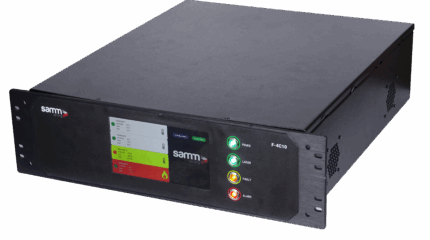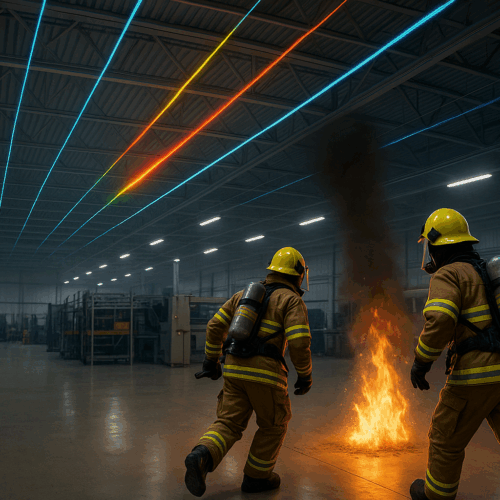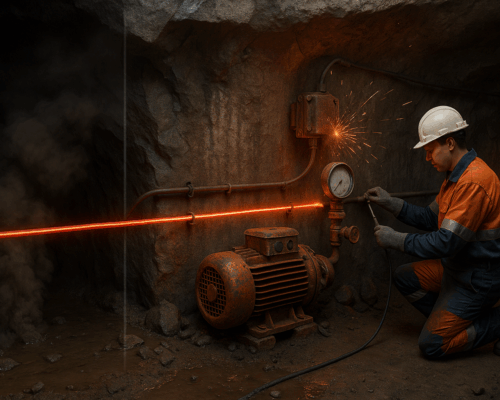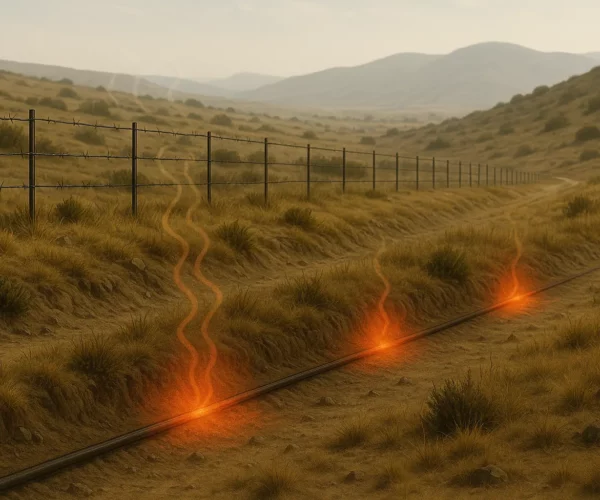The risk of fire is one of the most devastating threats to your business continuity and valuable assets. When traditional fire alarm systems fall short, unpredictable disasters can arise for your operations. It is precisely at this critical juncture that fiber optic based Distributed Temperature Sensing (DTS) systems step onto the stage: they transcend the limits of old technologies, offering you superior advantages.
Why Distributed Temperature Sensing (DTS)?


DTS's Unique Advantages: Why Should It Be Preferred?

Let No Risk Go Unseen
High Sensitivity for Instant Detection
DTS detects even millimetric temperature changes as small as 0.1°C instantly. Spot fires well before smoke even appears; gain a vital timeframe for intervention before they escalate into catastrophes, thereby securing your business continuity and preventing potential losses.
Long-Distance Surveillance
With a single fiber optic cable, you can perform continuous temperature monitoring up to 40 kilometers. For vast areas like tunnels, massive warehouses, or kilometers-long energy lines, DTS offers uninterrupted coverage that traditional point sensors can never achieve. This uninterrupted coverage provides complete protection for your large and critical infrastructures against future challenges.
Costs Down, Value Up
Low Total Operating Cost
The absence of moving parts and field electronics in DTS systems means minimal maintenance is required, significantly reducing your operating expenses. Against the high maintenance and replacement costs of traditional systems, DTS offers tangible long-term savings. This allows you to strategically free your business from its overall cost burden, not just immediate expenses.
Environmentally Friendly Energy Efficiency
Containing passive components, fiber optic systems consume incomparably less energy compared to traditional solutions. This not only drastically reduces your energy costs but also powerfully supports environmental sustainability by reducing your carbon footprint, thereby contributing to your modern business ethos by fulfilling your environmental responsibilities.


Compatibility with Every System
Unrivaled Environmental Resistance
Fiber optic cables exhibit high resistance to the most destructive environmental factors such as electromagnetic interference (EMI), extreme humidity, water contact, corrosion, dense dust, and smoke. This ultra-robustness guarantees your system will deliver continuous and reliable performance for up to 20 years even in the harshest and most dangerous environments.
Seamless Integration Capability
DTS integrates smoothly with widely used industrial standards like Modbus, TCP/IP, and Ethernet. By easily connecting to your existing centralized management systems (SCADA, DCS, BMS), it centralizes data flow and strengthens your decision-making processes.
Smart Management, Maximum Control
Smart and Flexible Zone Management
You can create hundreds of distinct detection zones along the cable, defining custom alarm thresholds, alert scenarios, and intervention rules for each. For instance, in a tunnel, fans can be automatically activated based on temperature, while even a minimal temperature increase in a sensitive cable tray can trigger an immediate alarm.
Continuous and Real-Time Operational Insights
Track temperature values across your facility in real-time, moment by moment. This allows you to not only identify fire risks but also detect and intervene early in cases of equipment overheating or potential malfunctions.

DTS: The Insurance of a Strategic Investment
Fiber Optic Based Distributed Temperature Sensing (DTS) systems are not merely a fire detection solution; they are a comprehensive safety shield that elevates your operational efficiency to its peak and minimizes potential risks. It provides uninterrupted safety and operational excellence across a wide spectrum, from tunnels and power plants to data centers, pipelines, warehouses, and even explosive and high-temperature environments. In today’s rapidly changing industrial landscape, as new standards are set in safety and efficiency, investing in DTS is no longer just an option for your business continuity; it is a critical step to strengthen your operations against future challenges and protect against the unpredictable costs that potential risks may create.
DTS vs. Traditional Systems
| Feature | DTS Systems | Traditional Systems |
| Coverage Area | Up to 40 km Continuous Linear (Whole Facility) | Point / Limited (Dependent on Fixed Points) |
| Detection Speed / Response | 0.1°C with Instant Early Anomaly Detection | Upon Fire/Smoke Occurrence (Delayed Due to Gaps) |
| Maintenance & Total Cost | Minimal Maintenance, 20-Year Lifespan, Significant Savings | High Maintenance, Frequent Replacement, Periodic Calibration |
| Scalability | Easily Expandable by Adding to Existing Cable | Requires Additional Sensor Installation and Extensive New Cabling |
| Environmental Resilience | Full Immunity in Harsh Environments (Dust, Humidity, EMI, Explosives) | Affected by Dust, Humidity, EMI, Explosives; Performance Decreases |
| Energy Consumption | Incomparably Low (Due to Passive Structure) | High (Due to Active Electronic Components) |
| Structural Safety | Passive, Inherently Safe (No Electrical Risk) | Contains Electrical Risk (Potential for Sparking) |
| Data & Monitoring Depth | Real-time Profile, Proactive Management Capability | Simple Alarm Information / Delayed Data |



